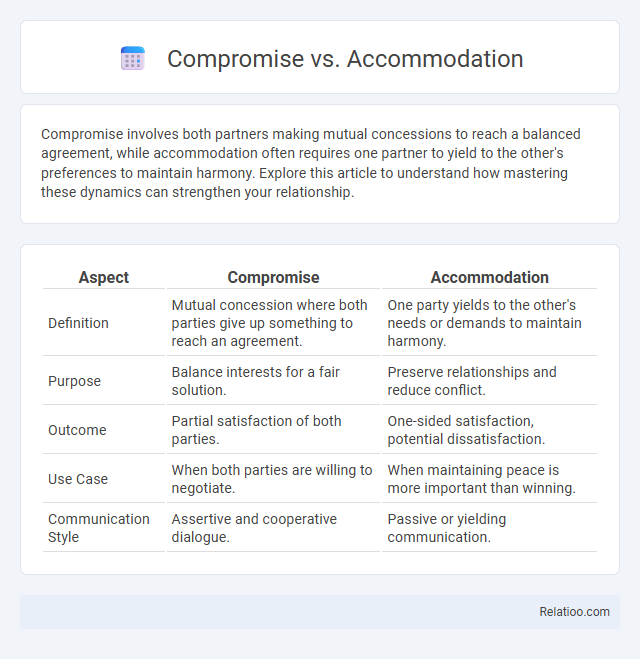Compromise involves both partners making mutual concessions to reach a balanced agreement, while accommodation often requires one partner to yield to the other's preferences to maintain harmony. Explore this article to understand how mastering these dynamics can strengthen your relationship.
Table of Comparison
| Aspect | Compromise | Accommodation |
|---|---|---|
| Definition | Mutual concession where both parties give up something to reach an agreement. | One party yields to the other's needs or demands to maintain harmony. |
| Purpose | Balance interests for a fair solution. | Preserve relationships and reduce conflict. |
| Outcome | Partial satisfaction of both parties. | One-sided satisfaction, potential dissatisfaction. |
| Use Case | When both parties are willing to negotiate. | When maintaining peace is more important than winning. |
| Communication Style | Assertive and cooperative dialogue. | Passive or yielding communication. |
Understanding Compromise and Accommodation
Understanding compromise involves finding a middle ground where all parties make concessions to reach a mutually acceptable solution. Accommodation emphasizes yielding to others' needs or desires to preserve harmony or avoid conflict, often prioritizing relationships over personal preferences. Distinguishing these approaches clarifies that compromise balances interests, whereas accommodation may sacrifice self-interest for cooperation.
Key Differences Between Compromise and Accommodation
Compromise involves each party making mutual concessions to reach a middle ground, balancing conflicting interests, while accommodation prioritizes one party yielding to maintain harmony without demanding concessions. The key difference lies in compromise's reciprocal nature versus accommodation's one-sided adjustment, affecting negotiation dynamics and relationship outcomes. Understanding when to apply compromise or accommodation can optimize conflict resolution strategies based on situational priorities and desired results.
Psychological Foundations of Compromise
Compromise, accommodation, and collaboration differ fundamentally in their psychological underpinnings, with compromise emphasizing mutual concession to resolve conflicts, accommodation prioritizing harmony by yielding to others' preferences, and collaboration aiming for integrative solutions that satisfy all parties. The psychological foundation of compromise lies in balanced assertiveness and cooperativeness, allowing individuals to maintain relationships while addressing core needs moderately. Your ability to recognize these dynamics enhances interpersonal negotiation and promotes emotional intelligence in conflict resolution.
The Role of Accommodation in Conflict Resolution
Accommodation in conflict resolution emphasizes yielding to others' needs or desires to maintain harmony, particularly effective in situations where preserving relationships is more important than asserting one's position. Unlike compromise, which involves mutual concessions, accommodation prioritizes one party's concession, reducing immediate tension and fostering long-term cooperation. This approach is especially valuable in organizational and interpersonal conflicts where trust and ongoing collaboration are critical for success.
Benefits of Compromise in Relationships
Compromise in relationships fosters mutual respect by encouraging both partners to find common ground, enhancing emotional intimacy and trust. Your willingness to compromise promotes effective communication and reduces conflicts, creating a balanced and supportive environment. This process strengthens relationship resilience by ensuring that both individuals feel valued and understood.
When Accommodation Works Best
Accommodation works best when preserving harmony and maintaining relationships is more important than winning an argument or achieving a specific outcome. You benefit from choosing accommodation in situations where the issue is minor or when the other party has more expertise or a stronger stake in the decision. This approach prioritizes empathy and cooperation, fostering goodwill and long-term collaboration.
Potential Drawbacks of Compromise
Compromise often involves each party giving up something, which can lead to suboptimal solutions that neither fully support Your original goals nor address core concerns, potentially fostering resentment. While accommodation prioritizes harmony by yielding to others' preferences, it risks neglecting Your own needs. Recognizing the potential drawbacks of compromise, such as diluted outcomes and unresolved conflicts, is crucial for selecting the most effective conflict resolution strategy.
Risks Associated with Over-Accommodation
Over-accommodation occurs when you excessively adjust your behavior or decisions to please others, which can lead to resentment and loss of personal boundaries. Unlike compromise or balanced negotiation, over-accommodation risks undermining your interests and weakening your position in relationships or business dealings. Recognizing these dangers helps maintain a healthy balance between cooperation and self-respect.
Practical Examples: Compromise vs Accommodation
In workplace conflicts, compromise involves both parties making mutual concessions, such as two departments agreeing to split resources equally. Accommodation occurs when one party yields entirely to the other's demands, like an employee accepting a manager's decision to change project deadlines without objection. Practical examples illustrate compromise as a balanced give-and-take solution, whereas accommodation emphasizes yielding to maintain harmony.
Choosing the Right Approach for Effective Conflict Management
Choosing the right approach for effective conflict management depends on understanding the subtle differences between compromise, accommodation, and collaboration. Compromise involves each party making mutual concessions, while accommodation requires one party yielding to maintain harmony. Your ability to assess the situation and select the ideal strategy ensures a balanced resolution that maintains relationships and meets core needs.

Infographic: Compromise vs Accommodation
 relatioo.com
relatioo.com